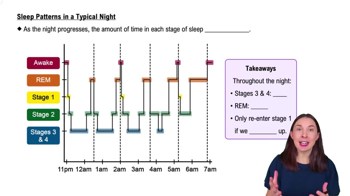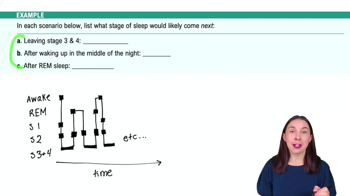Table of contents
- 1. Introduction to Psychology1h 43m
- 2. Psychology Research2h 20m
- 3. Biological Psychology2h 41m
- 4. Sensation and Perception28m
- 5. Consciousness and Sleep32m
- 6. Learning41m
- 7. Memory34m
- 8. Cognition37m
- 9. Emotion and Motivation35m
- 10. Developmental Psychology33m
- 11. Personality48m
- 12. Social Psychology41m
- 13. Stress and Health41m
- 14. Psychological Disorders44m
- 15. Treatment47m
5. Consciousness and Sleep
Sleep
Struggling with Psychology?
Join thousands of students who trust us to help them ace their exams!Watch the first videoMultiple Choice
When Helle was born, her parents agreed to allow her to participate in a research project that investigates the development of motor skills in children. Every year, Helle's parents complete a survey answering questions about how Helle's motor skills have changed. The researchers are using only one group of parents and children for the study. Helle and her parents are participating in a study that uses a _____ design.
A
longitudinal
B
cross-sectional
C
cross-sequential
D
combination of cross-sectional and cross-sequential
 Verified step by step guidance
Verified step by step guidance1
Understand the key characteristics of each research design option: longitudinal, cross-sectional, cross-sequential, and combination of cross-sectional and cross-sequential.
A longitudinal design involves studying the same group of participants over a period of time to observe changes and developments.
A cross-sectional design involves studying different groups of participants at one point in time to compare differences across groups.
A cross-sequential design combines elements of both longitudinal and cross-sectional designs, studying several groups over time.
Since the study involves observing the same group of parents and children (Helle and her parents) over multiple years, it aligns with the characteristics of a longitudinal design.

 3:25m
3:25mWatch next
Master Circadian Rhythms with a bite sized video explanation from Hannah Gordils
Start learningRelated Videos
Related Practice


































































































![Race, Genes and IQ Differences | Bret Weinstein [Mini Clip]](https://img.youtube.com/vi/IztL_m3pd70/mqdefault.jpg)



































































































